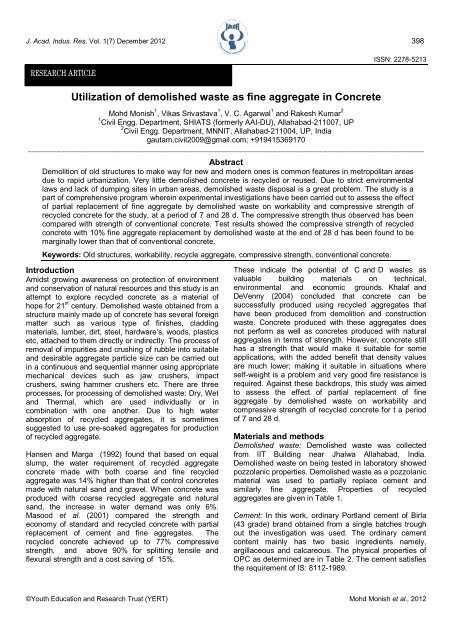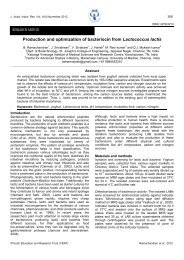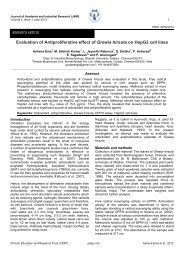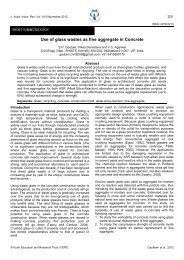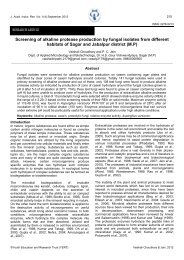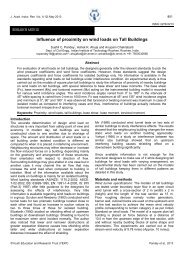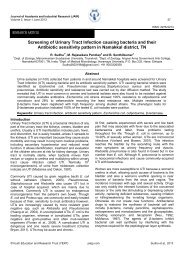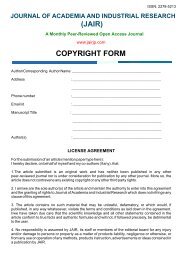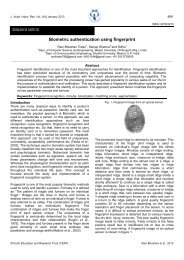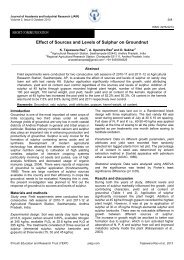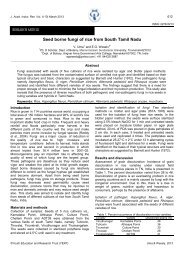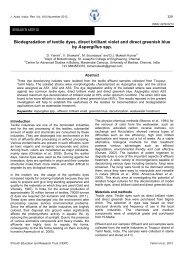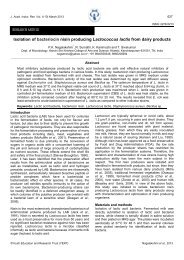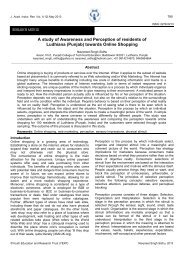Utilization of demolished waste as fine aggregate in Concrete
Utilization of demolished waste as fine aggregate in Concrete
Utilization of demolished waste as fine aggregate in Concrete
Create successful ePaper yourself
Turn your PDF publications into a flip-book with our unique Google optimized e-Paper software.
J. Acad. Indus. Res. Vol. 1(7) December 2012 398RESEARCH ARTICLEISSN: 2278-5213<strong>Utilization</strong> <strong>of</strong> <strong>demolished</strong> <strong>w<strong>as</strong>te</strong> <strong>as</strong> <strong>f<strong>in</strong>e</strong> <strong>aggregate</strong> <strong>in</strong> <strong>Concrete</strong>Mohd Monish 1 , Vik<strong>as</strong> Sriv<strong>as</strong>tava 1 , V. C. Agarwal 1 and Rakesh Kumar 21 Civil Engg. Department, SHIATS (formerly AAI-DU), Allahabad-211007, UP2 Civil Engg. Department, MNNIT, Allahabad-211004, UP, Indiagautam.civil2009@gmail.com; +919415369170______________________________________________________________________________________________AbstractDemolition <strong>of</strong> old structures to make way for new and modern ones is common features <strong>in</strong> metropolitan are<strong>as</strong>due to rapid urbanization. Very little <strong>demolished</strong> concrete is recycled or reused. Due to strict environmentallaws and lack <strong>of</strong> dump<strong>in</strong>g sites <strong>in</strong> urban are<strong>as</strong>, <strong>demolished</strong> <strong>w<strong>as</strong>te</strong> disposal is a great problem. The study is apart <strong>of</strong> comprehensive program where<strong>in</strong> experimental <strong>in</strong>vestigations have been carried out to <strong>as</strong>sess the effect<strong>of</strong> partial replacement <strong>of</strong> <strong>f<strong>in</strong>e</strong> <strong>aggregate</strong> by <strong>demolished</strong> <strong>w<strong>as</strong>te</strong> on workability and compressive strength <strong>of</strong>recycled concrete for the study, at a period <strong>of</strong> 7 and 28 d. The compressive strength thus observed h<strong>as</strong> beencompared with strength <strong>of</strong> conventional concrete. Test results showed the compressive strength <strong>of</strong> recycledconcrete with 10% <strong>f<strong>in</strong>e</strong> <strong>aggregate</strong> replacement by <strong>demolished</strong> <strong>w<strong>as</strong>te</strong> at the end <strong>of</strong> 28 d h<strong>as</strong> been found to bemarg<strong>in</strong>ally lower than that <strong>of</strong> conventional concrete.Keywords: Old structures, workability, recycle <strong>aggregate</strong>, compressive strength, conventional concrete.IntroductionAmidst grow<strong>in</strong>g awareness on protection <strong>of</strong> environmentand conservation <strong>of</strong> natural resources and this study is anattempt to explore recycled concrete <strong>as</strong> a material <strong>of</strong>hope for 21 st century. Demolished <strong>w<strong>as</strong>te</strong> obta<strong>in</strong>ed from <strong>as</strong>tructure ma<strong>in</strong>ly made up <strong>of</strong> concrete h<strong>as</strong> several foreignmatter such <strong>as</strong> various type <strong>of</strong> f<strong>in</strong>ishes, cladd<strong>in</strong>gmaterials, lumber, dirt, steel, hardware’s, woods, pl<strong>as</strong>ticsetc, attached to them directly or <strong>in</strong>directly. The process <strong>of</strong>removal <strong>of</strong> impurities and crush<strong>in</strong>g <strong>of</strong> rubble <strong>in</strong>to suitableand desirable <strong>aggregate</strong> particle size can be carried out<strong>in</strong> a cont<strong>in</strong>uous and sequential manner us<strong>in</strong>g appropriatemechanical devices such <strong>as</strong> jaw crushers, impactcrushers, sw<strong>in</strong>g hammer crushers etc. There are threeprocesses, for process<strong>in</strong>g <strong>of</strong> <strong>demolished</strong> <strong>w<strong>as</strong>te</strong>: Dry, Wetand Thermal, which are used <strong>in</strong>dividually or <strong>in</strong>comb<strong>in</strong>ation with one another. Due to high waterabsorption <strong>of</strong> recycled <strong>aggregate</strong>s, it is sometimessuggested to use pre-soaked <strong>aggregate</strong>s for production<strong>of</strong> recycled <strong>aggregate</strong>.Hansen and Marga (1992) found that b<strong>as</strong>ed on equalslump, the water requirement <strong>of</strong> recycled <strong>aggregate</strong>concrete made with both coarse and <strong>f<strong>in</strong>e</strong> recycled<strong>aggregate</strong> w<strong>as</strong> 14% higher than that <strong>of</strong> control concretesmade with natural sand and gravel. When concrete w<strong>as</strong>produced with coarse recycled <strong>aggregate</strong> and naturalsand, the <strong>in</strong>cre<strong>as</strong>e <strong>in</strong> water demand w<strong>as</strong> only 6%.M<strong>as</strong>ood et al. (2001) compared the strength andeconomy <strong>of</strong> standard and recycled concrete with partialreplacement <strong>of</strong> cement and <strong>f<strong>in</strong>e</strong> <strong>aggregate</strong>s. Therecycled concrete achieved up to 77% compressivestrength, and above 90% for splitt<strong>in</strong>g tensile andflexural strength and a cost sav<strong>in</strong>g <strong>of</strong> 15%.These <strong>in</strong>dicate the potential <strong>of</strong> C and D <strong>w<strong>as</strong>te</strong>s <strong>as</strong>valuable build<strong>in</strong>g materials on technical,environmental and economic grounds. Khalaf andDeVenny (2004) concluded that concrete can besuccessfully produced us<strong>in</strong>g recycled <strong>aggregate</strong>s thathave been produced from demolition and construction<strong>w<strong>as</strong>te</strong>. <strong>Concrete</strong> produced with these <strong>aggregate</strong>s doesnot perform <strong>as</strong> well <strong>as</strong> concretes produced with natural<strong>aggregate</strong>s <strong>in</strong> terms <strong>of</strong> strength. However, concrete stillh<strong>as</strong> a strength that would make it suitable for someapplications, with the added benefit that density valuesare much lower; mak<strong>in</strong>g it suitable <strong>in</strong> situations whereself-weight is a problem and very good fire resistance isrequired. Aga<strong>in</strong>st these backdrops, this study w<strong>as</strong> aimedto <strong>as</strong>sess the effect <strong>of</strong> partial replacement <strong>of</strong> <strong>f<strong>in</strong>e</strong><strong>aggregate</strong> by <strong>demolished</strong> <strong>w<strong>as</strong>te</strong> on workability andcompressive strength <strong>of</strong> recycled concrete for t a period<strong>of</strong> 7 and 28 d.Materials and methodsDemolished <strong>w<strong>as</strong>te</strong>: Demolished <strong>w<strong>as</strong>te</strong> w<strong>as</strong> collectedfrom IIT Build<strong>in</strong>g near Jhalwa Allahabad, India.Demolished <strong>w<strong>as</strong>te</strong> on be<strong>in</strong>g tested <strong>in</strong> laboratory showedpozzolanic properties. Demolished <strong>w<strong>as</strong>te</strong> <strong>as</strong> a pozzolanicmaterial w<strong>as</strong> used to partially replace cement andsimilarly <strong>f<strong>in</strong>e</strong> <strong>aggregate</strong>. Properties <strong>of</strong> recycled<strong>aggregate</strong>s are given <strong>in</strong> Table 1.Cement: In this work, ord<strong>in</strong>ary Portland cement <strong>of</strong> Birla(43 grade) brand obta<strong>in</strong>ed from a s<strong>in</strong>gle batches troughout the <strong>in</strong>vestigation w<strong>as</strong> used. The ord<strong>in</strong>ary cementcontent ma<strong>in</strong>ly h<strong>as</strong> two b<strong>as</strong>ic <strong>in</strong>gredients namely,argillaceous and calcareous. The physical properties <strong>of</strong>OPC <strong>as</strong> determ<strong>in</strong>ed are <strong>in</strong> Table 2. The cement satisfiesthe requirement <strong>of</strong> IS: 8112-1989.©Youth Education and Research Trust (YERT) Mohd Monish et al., 2012
J. Acad. Indus. Res. Vol. 1(7) December 2012 399Table 1. Physical properties <strong>of</strong> recycled <strong>aggregate</strong>.PropertiesObserved valuesColourP<strong>in</strong>kish brownSpecific gravity 2.5Water absorption (%) 3.03-4.5Table 2. Properties <strong>of</strong> cement.PropertiesRequirementObserved<strong>as</strong> pervaluesIS:8112-1989Normal consistency - 28%Initial sett<strong>in</strong>g time 30 m<strong>in</strong> 113 m<strong>in</strong>F<strong>in</strong>al sett<strong>in</strong>g time 600 m<strong>in</strong> 317 m<strong>in</strong>3 d compressive strength 23 N/mm 2 23.67 N/mm 27 d compressive strength 33 N/mm 2 34.67 N/mm 228 d compressive strength 43 N/mm 2 44.33 N/mmSoundness test Up to 10 mm 2.5 mmF<strong>in</strong>eness test (90 µ sieve) Up to 10% 0.98%ISsievesizeTable 3. Sieve analysis (F<strong>in</strong>e <strong>aggregate</strong>).Weight Cumulativereta<strong>in</strong>ed weight(g) reta<strong>in</strong>ed (g)% cumulativeweight reta<strong>in</strong>ed10 mm 0 0 0.004.75 mm 110 110 11.002.36 mm 52 162 16.201.18 mm 175 337 33.70600 µ 128 465 46.50300 µ 250 715 71.50150 µ 240 955 95.50ISsievesizeTable 4. Properties <strong>of</strong> <strong>f<strong>in</strong>e</strong> <strong>aggregate</strong>.PropertiesObserved valuesF<strong>in</strong>eness modulus 2.74Specific gravity 2.63Table 5. Sieve analysis (Coarse <strong>aggregate</strong>).WeightCumulativereta<strong>in</strong>edweight reta<strong>in</strong>ed (g)(g)% Cumulativeweightreta<strong>in</strong>ed16 mm 0 0 0.0012.5 mm 124 124 2.4810 mm 1186 1310 26.204.75 mm 3520 4830 96.602.36 mm 115 4945 98.901.18 mm 55 5000 100.00600 µ - 5000 100.00300 µ - 5000 100.00150 µ - 5000 100.00Table 6. Properties <strong>of</strong> <strong>aggregate</strong>.PropertiesObserved valuesF<strong>in</strong>eness modulus 6.22Specific gravity 2.64F<strong>in</strong>e <strong>aggregate</strong>: The <strong>f<strong>in</strong>e</strong> <strong>aggregate</strong> is locally availableriver sand, which is p<strong>as</strong>sed through 4.75 mm sieve.Result <strong>of</strong> sieve analysis <strong>of</strong> <strong>f<strong>in</strong>e</strong> <strong>aggregate</strong> and physicalproperties are given <strong>in</strong> Table 3 and 4 respectively.Coarse <strong>aggregate</strong>: The coarse <strong>aggregate</strong> locallyavailable crushed stone <strong>aggregate</strong>, 12 mm maximum <strong>of</strong>s<strong>in</strong>gle lot size h<strong>as</strong> been used trough out the experimentthe specific gravity <strong>of</strong> coarse <strong>aggregate</strong> w<strong>as</strong> 2.7. Thegrad<strong>in</strong>g <strong>of</strong> coarse <strong>aggregate</strong> are given <strong>in</strong> the Table 5 and6.Water: Potable water is used for mix<strong>in</strong>g and cur<strong>in</strong>g. Onaddition <strong>of</strong> higher percentage <strong>of</strong> <strong>demolished</strong> <strong>w<strong>as</strong>te</strong> therequirement <strong>of</strong> water <strong>in</strong>cre<strong>as</strong>es for the same workability.Thus a constant slump h<strong>as</strong> been the criteria fir waterrequirement but the specimens hav<strong>in</strong>g 0% <strong>demolished</strong><strong>w<strong>as</strong>te</strong>, w/c <strong>of</strong> 0.50 h<strong>as</strong> been used.<strong>Concrete</strong>: The concrete mix design is done <strong>in</strong>accordance with IS: 10262 (1982). The cement content<strong>in</strong> the mix design is taken <strong>as</strong> 380 kg/cu. m 3 whichsatisfies m<strong>in</strong>imum requirement <strong>of</strong> 300 kg/cu. m <strong>in</strong> orderto avoid the ball<strong>in</strong>g effect. Good stone <strong>aggregate</strong> andnatural river sand <strong>of</strong> zone-II w<strong>as</strong> used <strong>as</strong> coarse<strong>aggregate</strong> and <strong>f<strong>in</strong>e</strong> <strong>aggregate</strong> respectively. Maximumsize <strong>of</strong> coarse <strong>aggregate</strong> w<strong>as</strong> 12.5 mm. a sieve analysisconform<strong>in</strong>g to IS: 383-1970 w<strong>as</strong> carried out for both the<strong>f<strong>in</strong>e</strong> and coarse <strong>aggregate</strong>. This study is a part <strong>of</strong>comprehensive programme where<strong>in</strong> experimental<strong>in</strong>vestigations have been carried out to <strong>as</strong>sess the effect<strong>of</strong> replacement <strong>of</strong> regular material by a cheaper substitutei.e. <strong>demolished</strong> <strong>w<strong>as</strong>te</strong> on strength <strong>of</strong> concrete. For thisstudy cubes <strong>of</strong> 100 mm size were c<strong>as</strong>t by replac<strong>in</strong>g <strong>f<strong>in</strong>e</strong><strong>aggregate</strong> by <strong>demolished</strong> <strong>w<strong>as</strong>te</strong>. Compressive strength <strong>of</strong>this recycled concrete were observed and compared withthose <strong>of</strong> natural <strong>aggregate</strong> concrete. To achieve thiscomparative study, cubes were c<strong>as</strong>t replac<strong>in</strong>g <strong>f<strong>in</strong>e</strong><strong>aggregate</strong>s by 10%, 20%, and 30% with <strong>demolished</strong><strong>w<strong>as</strong>te</strong> for a comparative study with respect toconventional concrete. These specimens were testedafter 7 and 28 d. To identify cube strength, a mixproportion <strong>of</strong> 1:1.67:3.33 w<strong>as</strong> used dur<strong>in</strong>g the<strong>in</strong>vestigation.Results and discussionThe observations made dur<strong>in</strong>g the test <strong>of</strong> cubes aresummarized <strong>as</strong> workability and compressive strength arepresented <strong>in</strong> tabular form (Table 7). Three specimens eachhav<strong>in</strong>g 0%, 10%, 20%, and 30% <strong>demolished</strong> <strong>w<strong>as</strong>te</strong> <strong>as</strong> <strong>f<strong>in</strong>e</strong><strong>aggregate</strong> replacement for mix <strong>of</strong> 1:1.67:3.33 were c<strong>as</strong>tand tested after 7 days and 28 d <strong>in</strong> order to have acomparative study.Workability: Workability is the relative e<strong>as</strong>e with whichconcrete can be mixed, placed, compacted and f<strong>in</strong>ished.While c<strong>as</strong>t<strong>in</strong>g specimens, slump test were carried out todeterm<strong>in</strong>e the workability <strong>of</strong> different samples <strong>as</strong> perIS: 6461-1973 (Fig. 1).©Youth Education and Research Trust (YERT) Mohd Monish et al., 2012
J. Acad. Indus. Res. Vol. 1(7) December 2012 400Table 7 shows the variations <strong>of</strong> slump with water cementratio for recycled concrete mixes.Table 7. Slump and average compressive strength <strong>of</strong> concrete.Types <strong>of</strong> concreteAverage compressivestrength (N/mm 2 Slump)(mm)7 d 28 dConventionalconcrete (0% DW)33 38 3010% F.A.R. concrete 31 36 2620% F.A.R. concrete 28 33 2530% F.A.R. concrete 27 31 22Compressive strength: Cubical specimens were c<strong>as</strong>t forthe determ<strong>in</strong>ation <strong>of</strong> compressive strength. Theseobservations are presented <strong>in</strong> tabular form <strong>as</strong> compressivestrength values (Table 8). Cubes up to 20% <strong>of</strong> <strong>f<strong>in</strong>e</strong><strong>aggregate</strong> replaced by <strong>demolished</strong> <strong>w<strong>as</strong>te</strong> give strengthcloser to the strength <strong>of</strong> pla<strong>in</strong> concrete cubes and strengthretention <strong>of</strong> 86.84% for recycled concrete mix (Fig. 2).Table 8. Comparative statement <strong>of</strong> strength andeconomy (mix 1:1.67:3.33).ItemsStrength(KN/mm 2 )Cost per m 3(Rupees)Decre<strong>as</strong>e<strong>in</strong> cost(%)Natural concrete 38 3613.32 -Recycled concretewith 10% <strong>f<strong>in</strong>e</strong><strong>aggregate</strong>replacementRecycled concretewith 20% <strong>f<strong>in</strong>e</strong><strong>aggregate</strong>replacementRecycled concretewith 30% <strong>f<strong>in</strong>e</strong><strong>aggregate</strong>replacement36 3537.52 13.1833 3559 1.5031 3390 6.18ConclusionThe follow<strong>in</strong>g conclusions are drawn from the experimentalstudy.1. Recycled <strong>aggregate</strong> concrete may be an alternative tothe conventional concrete.2. Water required produc<strong>in</strong>g the same workability<strong>in</strong>cre<strong>as</strong>es with the <strong>in</strong>cre<strong>as</strong>e <strong>in</strong> the percentage <strong>of</strong><strong>demolished</strong> <strong>w<strong>as</strong>te</strong>.3. Optimum replacement level <strong>of</strong> <strong>f<strong>in</strong>e</strong> <strong>aggregate</strong> withrecycled <strong>aggregate</strong> is 10%.Fig. 1. Workability <strong>of</strong> various percentage <strong>of</strong> F.A.R. concrete.Slump (mm)Compressive strength (KN/mm 2 )353025201510500% F.A.R.<strong>Concrete</strong>10% F.A.R.<strong>Concrete</strong>20% F.A.R.<strong>Concrete</strong>30%F.A.R.concreteFig. 2. Compressive strength <strong>of</strong> various percentage <strong>of</strong>F.A.R. concrete.40353025201510507 Days Compressive strength 28 Days Compressive strength0% F.A.R.<strong>Concrete</strong>10% F.A.R.<strong>Concrete</strong>20% F.A.R.<strong>Concrete</strong>30% F.A.R.<strong>Concrete</strong>References1. Hansen, T.C. and Marga, M. 1992. Strength <strong>of</strong> recycledconcrete made from coarse and <strong>f<strong>in</strong>e</strong> recycled concrete<strong>aggregate</strong>. Ibid .135: 605-612.2. IS: 456-1978. Code <strong>of</strong> practice for pla<strong>in</strong> and re<strong>in</strong>forced concrete.Indian Standard Institute, New Delhi.3. IS: 6461-1973. Properties <strong>of</strong> concrete (part VIII). Indian StandardInstitute, New Delhi.4. IS: 8112-1989. 43 Grade ord<strong>in</strong>ary Portland cement. IndianStandard Institute, New Delhi.5. Khalaf, F.M. and DeVenny, A.S. 2004. Performance <strong>of</strong> brick<strong>aggregate</strong> concrete at high temperatures. J. Mater. Civil Engg.16(6): 556-565.6. M<strong>as</strong>ood A., Ahmad, T., Arif, M. and Mahdi, F. 2001. W<strong>as</strong>temanagement strategies for concrete. Environ. Engg. Policy. 3:15-18.©Youth Education and Research Trust (YERT) Mohd Monish et al., 2012


